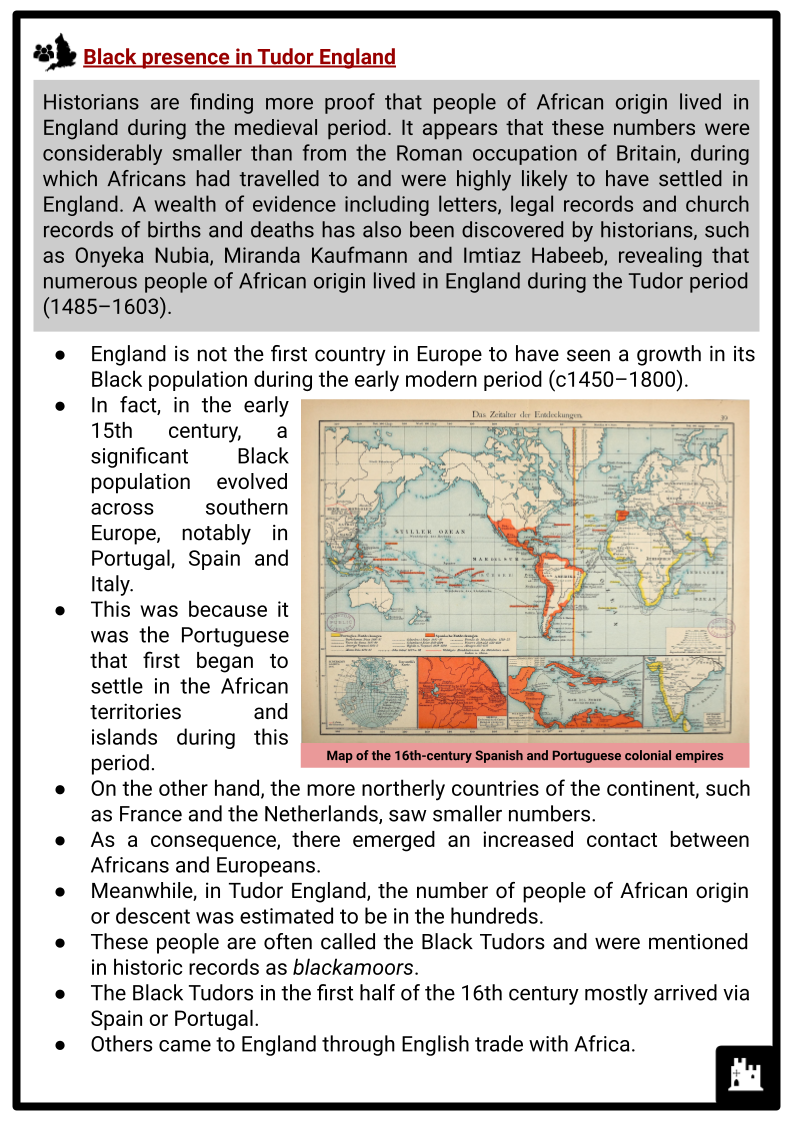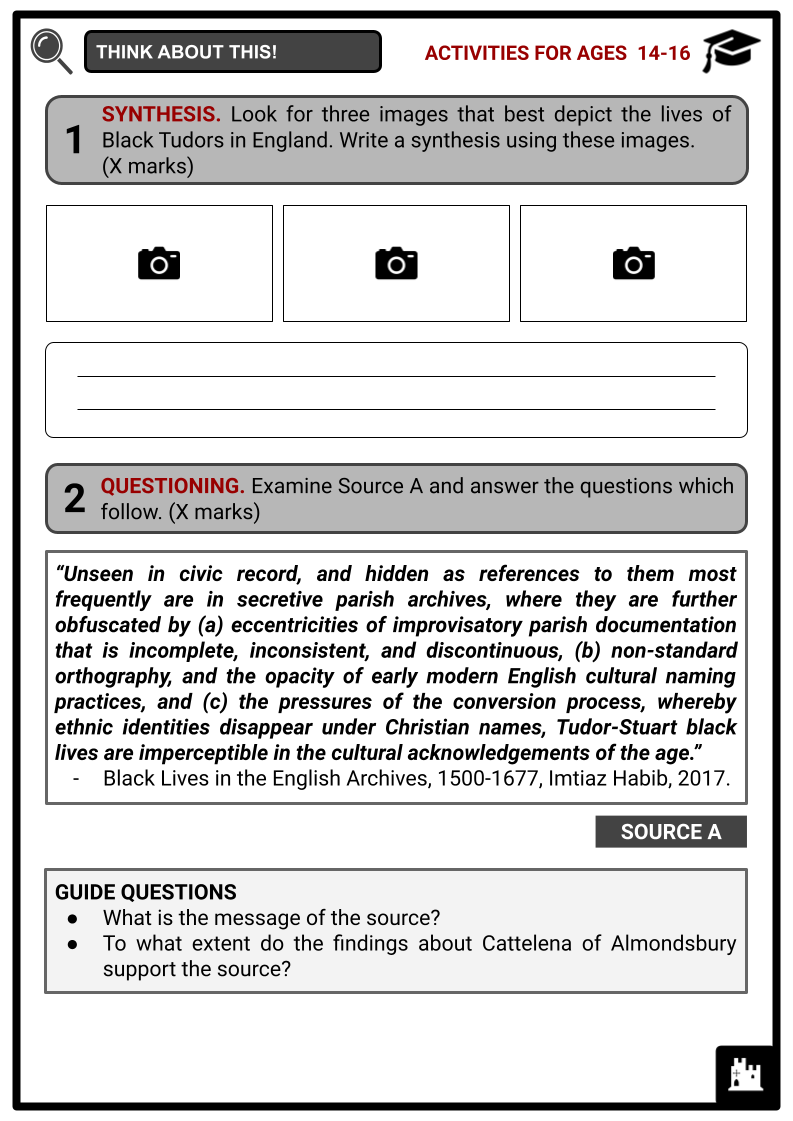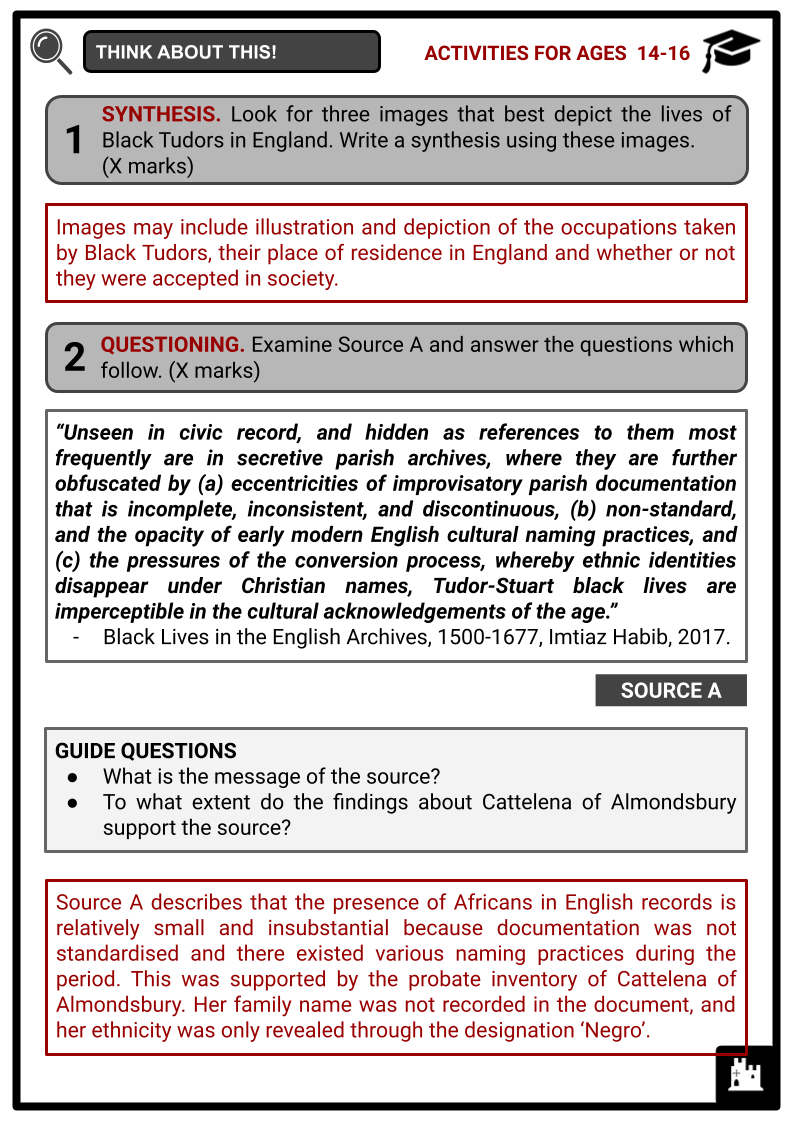Cattelena of Almondsbury Worksheets
Do you want to save dozens of hours in time? Get your evenings and weekends back? Be able to teach about Cattelena of Almondsbury to your students?
Our worksheet bundle includes a fact file and printable worksheets and student activities. Perfect for both the classroom and homeschooling!
Resource Examples
Click any of the example images below to view a larger version.
Fact File


Student Activities




Summary
- Black presence in Tudor England
- Cattelena of Almondsbury
Key Facts And Information
Let’s know more about Cattelena of Almondsbury!
Historians have found that numerous people of African origin lived in England not only during the Roman occupation of Britain and the medieval period, but also during the Tudor rule. One of the recorded Black Tudors was Cattelena of Almondsbury, an independent single woman. The probate inventory for Cattelena included a valuable cow and a number of humble possessions. This provides insights into Cattelena’s means of living and, more importantly, her status in Tudor society.

Black presence in Tudor England
- Historians are finding more proof that people of African origin lived in England during the medieval period. It appears that these numbers were considerably smaller than from the Roman occupation of Britain, during which Africans had travelled to and were highly likely to have settled in England. A wealth of evidence including letters, legal records and church records of births and deaths has also been discovered by historians, such as Onyeka Nubia, Miranda Kaufmann and Imtiaz Habeeb, revealing that numerous people of African origin lived in England during the Tudor period (1485–1603).
- England is not the first country in Europe to have seen a growth in its Black population during the early modern period (c1450–1800).
- In fact, in the early 15th century, a significant Black population evolved across southern Europe, notably in Portugal, Spain and Italy.
- This was because it was the Portuguese that first began to settle in the African territories and islands during this period.

- On the other hand, the more northerly countries of the continent, such as France and the Netherlands, saw smaller numbers.
- As a consequence, there emerged an increased contact between Africans and Europeans.
- Meanwhile, in Tudor England, the number of people of African origin or descent was estimated to be in the hundreds.
- These people are often called the Black Tudors and were mentioned in historic records as blackamoors.
- The Black Tudors in the first half of the 16th century mostly arrived via Spain or Portugal.
- Others came to England through English trade with Africa.
How did the Black Tudors come to England?
-
- Some came directly from Africa as traders or as ambassadors.
- Others arrived with the entourages of royals.
- Several travelled with merchants and aristocrats, especially when the English started to trade with Morocco and West Africa directly from the 1550s.
- Many came as the consequence of English privateering and raids on the Spanish empire.
- Parish registers from 1558 until the 17th century listed Black Tudors, which, aside from blackamoors, were described as ‘Neygers’, ‘Aethiopians’ and ‘Negroes’.
- These registers showed that the Africans were baptised, married to English people and buried in parish graveyards across the country, in both cities and the more rural areas.
- This suggests that Black Tudors resided in various locations in England.
- The Africans in Tudor England also took a variety of jobs, with a majority of them employed as servants. Others worked as weavers, sailors, labourers and musicians.
- Some of the Africans found to have lived in Tudor England are as follows:
- John Blanke, the royal trumpeter
- Jacques Francis, the salvage diver
- Diego, the circumnavigator
- Reasonable Blackman, the silk weaver
- Mary Fillis, servant
- Cattelena of Almondsbury
- Evidence of Black presence in Tudor England indicated that many of them were free members of society, contrary to the general view that all Africans were enslaved by the English. The reason for many Black Tudors’ legal status was that England did not participate in the slave trade until the first half of the 17th century. In fact, during the Tudor times, there was no legislation that explicitly forbade slavery in England, but neither was there a law that permitted it.
Cattelena of Almondsbury
- The experience of Black Tudors in England appears to be remarkable, owing to their independence. Unlike the majority of Africans across the rest of the Atlantic world, they were free, were paid wages, and were able to earn their own living and testify in court. They were integrated members of their local parishes and were baptised and married by the Church. They were employed at different levels of society. One of the known Africans from Tudor England was Cattelena of Almondsbury, one of a number of Black Tudors recorded in rural locations.
- Cattelena’s place and date of birth are unknown. Her Hispanic-sounding name suggests that her place of origin was connected to Spanish or Portuguese territories. As we have seen, many Africans came to Britain through such territories.
- She might have come to Bristol or might have initially worked as a servant for a landowning family in Gloucestershire.
Were there other Black Tudors who lived in rural locations?
- Parish registers showed baptisms and burials of Black Tudors in locations such as Cornwall, Devon, Cambridgeshire, Gloucestershire, Dorset, Kent, Northamptonshire, Somerset, Suffolk and Wiltshire. A man listed as ‘Thomas Bull, niger’ in the village of Eydon, Northamptonshire in 1545 is the earliest found in the registers.
- Between 1560 and 1640, it was revealed that at least 16 Africans were living in Bristol.
What evidence pointed to the existence of Cattelena of Almondsbury?
- In a probate inventory from the Bristol Record Office dated May 1625, Cattelena was described as a ‘single Negro woman’ and the goods she owned worth over £6 (approximately £852 in 2017) included the following: bedding, pots and pans, a pewter candlestick, a tin bottle, a dozen spoons, clothing, a coffer, and a cow.
- A probate inventory lists and estimates the value of the property owned by the deceased at the time of their death. It is often included in the will.
What does the probate inventory tell us about Cattelena?
- Cattelena was an independent, single woman who lived in the rural Gloucestershire village of Almondsbury until her death in around 1625.
- Her description from the inventory suggests that she was self-sufficient, similar to about 30% of Tudor women.
- Her main source of income appears to be her most valuable possession, a cow, valued at £3 and 10s in 1625. This was worth approximately £460 in 2017.
- Her cow supplied her with milk, cheese and butter, the surplus of which she sold to her neighbours.
- She likely kept her cow on the grassy area next to the village church, where it would have grazed. She would have milked it in the evening.
- The possession of a cow provided her opportunities for a degree of self-sufficiency.
- Despite her independent income, Cattelena was not very wealthy.
- The lack of furniture in the inventory indicates that she may have lived in a rented home. It is also possible that she shared her home with Helen Ford, the widow who handled her estate.
- Cattelena’s possessions, however humble, indicate that she had an independent status in Tudor England and was not enslaved at the time of her death.
Frequently Asked Questions
- What was Cattelena of Almondsbury's life like?
Cattelena was described as an "independent single woman" who made most of her living from possessing a cow.
- Why is it important to learn about Black Tudors?
Studying Black Tudors is crucial for fostering a more accurate and inclusive understanding of history. It challenges traditional narratives, correcting historical oversights and stereotypes while highlighting the diversity and interconnectedness of Tudor England.
- Who are the famous Black Tudors?
Historian Dr. Miranda Kaufmann has conducted research that sheds light on the lives of Black Tudors, including John Blanke, Diego, and Mary Fillis.
